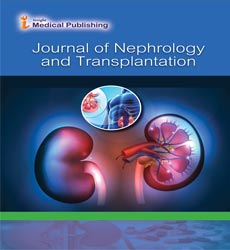Categories of Renal Replacement Therapy
Hissa Mohammed*
Department of Medicine, University of Kashihara, Sousse, Tunisia
- *Corresponding Author:
- Hissa Mohammed
Department of Medicine,
University of Kashihara,
Sousse,
Tunisia
E-mail: hasabi16@outlook.com
Received Date: October 11, 2021; Accepted Date: October 26, 2021; Published Date: October 30, 2021
Citation: Mohammed H (2021) Categories of Renal Replacement Therapy. J Nephrol Transplant Vol.5 No.4:e001.
Editorial Note
Renal Replacement Therapy (RRT) is a treatment for patients with renal failure which replaces renal function and removes waste products and excess water from the blood by mechanical filtration. This type of treatment is administered via an extravenous circuit equipped with a blood pump that drives venous blood through an artificial "kidney" membrane. Very rarely, the peritoneal cavity can be used to exchange electrolytes and solutes in the form of peritoneal dialysis.
Types of Renal Replacement Therapy
Hemodialysis therapy
Hemodialysis is a procedure that purifies blood using a dialysis machine and a special filter called an artificial kidney or dialyzer. In order for blood to enter the dialyzer, the doctor needs to create an entrance to the blood vessel. This is done with a small surgical procedure, usually performed on the arm. Hemodialysis is a treatment used to filter waste products and water from the blood, as it was done when the kidneys were healthy. Hemodialysis helps control blood pressure and balance important minerals in the blood, such as potassium, sodium, and calcium. Hemodialysis is performed at the dialysis center three times a week, so most of the week is without dialysis. Hemodialysis can also be done freely at home. Hemodialysis at home is usually done daily with the help of a partner.
Hemofiltration therapy
Hemofiltration is a renal replacement therapy used in the intensive care unit. It is usually used to treat Acute Kidney Injury (AKI), but it can also be used for multiple organ failure syndrome and sepsis. Hemofiltration are devices used in hemofiltration therapy to replace renal function in acute renal failure. The patient's blood flows into the machine and waste products and water are removed before the removed liquid is replaced and returned to the patient. Observations collected with more than 300 treatments suggest that hemofiltration may be superior to traditional hemodialysis. The main benefits of this treatment are hypertension, over hydration, and perhaps better control of uremic bone disease.
Hemodiafiltration therapy
Hemodiafiltration seems to replace renal function with dialysis. High convection correlated with a better clinical outcome. However, there may be technical barriers to achieving high blood flow sufficient for effective convection therapy. Despite optimized procedures, gradual increases in Trans membrane Pressure (TMP), blood viscosity due to blood concentration, and blood flow resistance may be unavoidable.
There are two possible solutions that can be operated automatically using the special software of the dialysis machine.
• On-demand Pre-dilution and
• On-demand Backflush
On-demand pre-dilution consists of automatic feedback from the machine, bypassing some of the filtered dialysate into predilution mode with a 200 ml infusion in 30 seconds while the ultrafiltration pump is stopped. This causes a sudden blood dilution and the parameters return to acceptable values. The performance of the filter is improved and the pressure change is mitigated.
Backflash on demand consists of automatic feedback from the machine triggered by TMP control. This creates an overpressure in the dialysate compartment by stopping filtration and rapidly injecting at least 100 ml of high-purity dialysate into the hollow fibers. This not only causes significant blood dilution, but also flushes the pores of the membrane, loosens the protein layer and improves the membrane. These are two examples of how technology can enable HDF adoption and overcome technical barriers to proper convective dose delivery.
This paper concludes about the severe forms of kidney disease requiring dialysis are treatable in some cases. Even if there is no cure, patients can still have a significant life on hemodialysis. The kidney is the only vital organ that can be mechanically replaced over the long term with reasonable success.
Open Access Journals
- Aquaculture & Veterinary Science
- Chemistry & Chemical Sciences
- Clinical Sciences
- Engineering
- General Science
- Genetics & Molecular Biology
- Health Care & Nursing
- Immunology & Microbiology
- Materials Science
- Mathematics & Physics
- Medical Sciences
- Neurology & Psychiatry
- Oncology & Cancer Science
- Pharmaceutical Sciences
